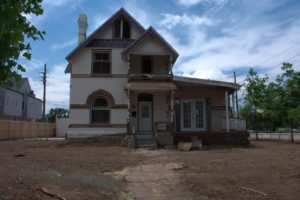The Effort to Save one of Park Hill’s Oldest Homes
In April 2022, Denver City Council unanimously made the 1889 Queen Anne house at 3435 Albion St. a local landmark, protecting it from demolition. The designation followed a year of uncertainty for the building, known as the Robinson House, during which Historic Denver helped to bring a preservation-minded buyer to the property.
Why It Matters
The house at 3435 Albion St. is one of Park Hill’s oldest extant homes. Named for the family that originally owned it, the Robinson House was listed on the National Register of Historic Places in 2003 for its architectural significance. Formerly known as Kate’s Restaurant, the building has been vacant since 2017 when the Garden, the business that followed Kate’s, closed shop. The house changed hands a number of times but eventually fell into disrepair due to lack of maintenance, vandalism and break-ins. The damage done to the interior and the size of the corner lot made the property an attractive candidate for a scrape-and-build project.
In 2021, prospective buyers applied for demolition eligibility. The city’s Landmark Preservation team posted it for demolition review, declaring that it was eligible to be a local landmark. Community members filed an intent to designate it a local landmark, and the deadline for the city to approve the demolition certificate was extended, opening the door for further discussion.
Historic Denver’s Role
During this extension, Historic Denver helped connect a preservation-friendly buyer with the sellers, and they eventually agreed to a deal. As a result, the demolition certificate application was rescinded and the threat to the historic house gone. The new owner is determined to save the house and also plans to use the vacant part of the lot to build a modest town home development of around five units.
Background
The building is one of the oldest remaining houses in the neighborhood. The house was built on speculation in 1889 for John Cook Jr.’s planned “North Capitol Hill Division,” during Denver’s first major housing boom. In the 1880s, largely fueled by the silver industry, Denver’s economy was booming and its population growing. As the need for housing grew, developers furiously platted land outside of the city’s core. Cook was one of these developers and built the Robinson House, advertising in the Denver Republican in May of 1889 to help attract buyers to an area he hoped would become just like Capitol Hill, its namesake. Cook’s dream was not to be realized, as the bottom fell out of the silver industry during the Panic of 1893. Denver’s economy slumped and the building boom stopped abruptly. The Robinson House represents this boom-and-bust cycle in Denver’s past and harkens back to a time when a horse-powered streetcar connected residents of Cook’s North Capitol Hill Division to Denver’s downtown amenities.
Get Involved
A Historic Denver membership not only provides financial support so that our staff can work every day on behalf of historic places like this one — it also demonstrates that our community cares. You can take action by becoming a member today.
Updated May 2022

